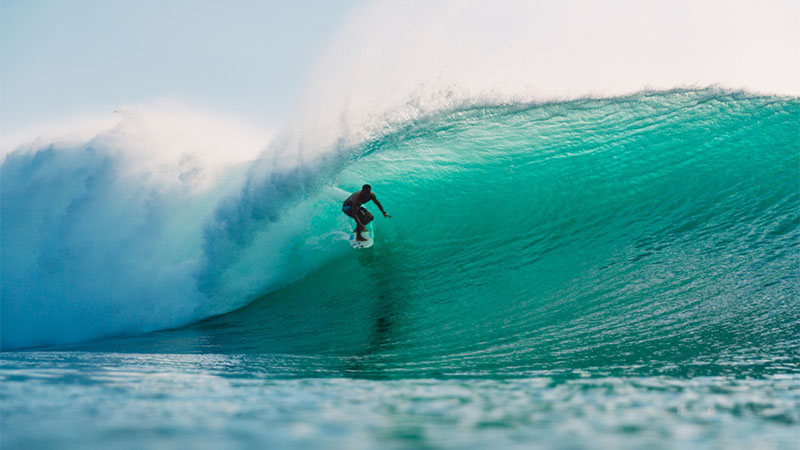We asked some keen surfers the best places to go surfing in Bali, where to find an epic swell when you’re surfing in Lombok, and more locations for surfing in Indonesia and further afield. Here are just a handful of the best spots for surfing in Southeast Asia, suitable for beginners to advanced surfers.
#1 Keramas: A popular spot for surfing in Bali, Indonesia
Not your typical Bali beach scene, Keramas’s black sand beach acts as a natural barrier between the rice paddies and the ocean. Fishing villages dot this stretch of the Gianyar coast, east of Denpasar. There are plenty of warungs (small family-owned establishments selling local food and drinks), while Hotel Komune and Beach Club Bali cater to those looking for some creature comforts.
At first glance, it looks like a beach break – but don’t be fooled. This smooth right hand wave peels over a sharp, shallow rocky reef. On smaller swells at higher tides, it’s almost mellow. You can enjoy a fast, fun ride from three foot to head high, with a hittable lip. On big days here surfing in Bali, it’s a long, fast barrelling tube, best on a mid to high tide, holding a swell of eight foot or more. It’s pretty full-on, so for expert surfers only.

When to go
Keramas is one of the most reliable surf breaks around. It’s consistently good in Bali’s wet season from October to March when quality waves are common. Other months are smaller and always to be avoided at low tides.
Good to know
Once a secluded and secret spot for surfing in Southeast Asia, Keramas is now catching the eye of surfers and often crowded on weekends and in peak tourist seasons. The other catch is the wind, which comes up onshore as early as 7am or 8am – it’s dawn patrol or nothing. Oh, and the black sand beach gets ridiculously hot on a sunny day, so wear some thongs/flip-flops!
#2 Padang Padang: an advanced surf break in Bali, Indonesia
Padang Padang has a very shallow left-hand reef break known as the “Balinese Pipeline” due to the large barrels that allow surfers to have excellent tube rides. Due to the powerful waves and shallow reed, it’s regarded by those surfing in Bali as the island’s most dangerous wave. The Balinese Pipeline is a favourite spot for surfing in Southeast Asia among top-notch surfers around the world and is only for expert surfers.
Beginners and intermediates looking for spots to go surfing in Bali can head to the mellow wave nearby called Padang Padang Rights. The waves break both left and right over the reef in front of a beautiful white sandy beach, which is safe for novices at high tide.
When to go
The left-hand waves only break neatly on a large swell, which is usually from April to October. But the rights are consistent all year round save for July and August when waves might get too big for beginners.
Good to know
The entrance to Padang Padang beach is cut through solid rock so getting there is an experience in itself. Usually, there’s a relaxed mix of locals and tourists hanging out at the beach, sunbathing and swimming during the day, and enjoying a sunset beer later in the evening. By the way, this beach was a location for the Julia Roberts movie Eat, Pray, Love. But don’t let that put you off!
#3 Desert Point: surfing in Lombok, Indonesia
Desert Point on the southwest coast of Lombok is also known as Bangko Bangko beach. It is a 400m left-hander surf break that tubes right from take off to finish. The wave often grows in size and gets faster as it finishes, breaking on sharp reefs roughly 100m off the beach. It can reach up to eight foot, offering double-overhead or maybe even triple-overhead tube rides. Because of this, it’s common to find crews from all over the world filming videos on surfing in Southeast Asia.
When to go
If you’re heading to Indonesia, April to October is the best time for surfing in Lombok, including at Desert Point. However, it can be packed then, with experienced surfers looking for fast tube rides.
Good to know
If you’re a beginner who’s keen to try out surfing in Lombok, there are a couple of smaller waves further down south, but Desert Point is the main attraction in this part of Indonesia and is for advanced surfers only.
#4 G-Land: a long left-hand in East Java, Indonesia
Grajagan, or G-Land as most people know it, is located on the eastern fringe of Grajagan Bay, in East Java, Indonesia. It’s part of Plengkung National Forest, one of the last wild pieces of jungle left on the densely inhabited island.
Surfing in Southeast Asia doesn’t get much better than this. Most surfers head here in search of a very long, world-class, barrelling left-hand reef/point break that’s been touted as one of the world’s best left-hand waves. On regular days, the waves are between four and six foot but on good days they can reach up to 12 or 15 foot. Less experienced surfers looking to have some fun can go surfing down at Tigertracks and 20/20s for a less intimidating wave.
When to go
The left-hand waves only break neatly on a large swell, which is usually from April to October. But the rights are consistent all year round save for July and August when waves might get too big for beginners.
Good to know
The entrance to Padang Padang beach is cut through solid rock so getting there is an experience in itself. Usually, there’s a relaxed mix of locals and tourists hanging out at the beach, sunbathing and swimming during the day, and enjoying a sunset beer later in the evening. By the way, this beach was a location for the Julia Roberts movie Eat, Pray, Love. But don’t let that put you off!Desert Point, Lombok, Indonesia
Desert Point on the southwest coast of Lombok is also known as Bangko Bangko beach. It is a 400m left-hander surf break that tubes right from take off to finish. The wave often grows in size and gets faster as it finishes, breaking on sharp reefs roughly 100m off the beach. The waves can reach up to eight foot, offering double-overhead or maybe even triple-overhead tube rides. Because of this, it’s common to find surf crews from all over the world filming surfing videos.
When to go
April to October is the best time to surf this break. However, it can be packed then, with experienced surfers looking for fast tube rides.
Good to know
There are a couple of smaller waves further down south for beginners but Desert Point is the main attraction and is for advanced surfers only.
G-Land, East Java, Indonesia
Grajagan, or G-Land as most people know it, is located on the eastern fringe of Grajagan Bay, in East Java, Indonesia. It’s part of Plengkung National Forest, one of the last wild pieces of jungle left on the densely inhabited island.
Most surfers head here in search of a very long, world-class, barrelling left-hand reef/point break that’s been touted as one of the world’s best left-hand waves. On regular days, the waves are between four and six foot but on good days they can reach up to 12 to 15 foot. Less experienced surfers looking to have some fun can go surfing down at Tigertracks and 20/20s for a less intimidating wave.
When to go
G-Land is good for surfing from mid-March to October but the best months are June to August. But it can get crowded in the peak time with up to 100 people trying to catch the waves.
Good to know
In the 80s and 90s, G-Land was considered a true hardcore surfer destination. In fact, taking a female partner, let alone kids, was not commonplace. But thanks to a decade worth of improvements to accessibility and the facilities, it’s perfect for families and couples too.
#5 Mentawai Islands: surfing in Indonesia’s West Sumatra province
Often touted as “Surf Disneyland” and “The best waves in the world”, these remote islands, 60 miles off the Sumatran mainland, actually live up to the hyperbole. A few years back, adventurous surfers had this paradise almost to themselves. Today a micro industry of surf boat charters and land-based surf camps have sprung up to cater for the increasing number of surfers willing to travel and bear the cost of finding the perfect wave in surf mecca.
To get the most out of these surf breaks, you’ll have to be an intermediate or advanced surfer. To get there, you’ll need to take a flight to Padang and either hop on a surf boat charter or a boat transfer to a surf camp. Most surf camps should have speedboat access to nearby breaks.
As for the surf breaks, where to start? Rifles, Hollow Trees (HT’s), Telescopes, No-Kandui, Macaronis – the list of spots at this popular location for surfing in Indonesia is endless.
When to go
There are great waves in this area all year round, though the ideal time to surf in the Mentawais is during the dry season, late March to early November, the southern hemisphere’s winter.
Good to know
The Mentawai Islands cluster just below the equator. They’re known as the doldrums because of light and variable winds and rip-roaring squalls. So when winter storms in the southern hemisphere start to boil the ocean surface, surfers flock from all over the globe to experience doldrums conditions and perfect storm swells.
#6 The Majestics: a right-hand surf break in the Philippines
The Majestics, a right-hand reef break off Catanduanes Island, earned the name from its cream coloured sand, clear waves and bright coral reefs. It’s a bit of a mission to get to – domestic flight from Manila; 2.5-hour drive to Puraran. But the journey is worth it! You’ll be rewarded with long barrel waves that are comparable in power and quality to those in Hawaii. The Majestics are generally for advanced surfers but there are also waves suitable for beginners further down the beach.
When to go
We recommend beginner surfers come between April and August, when the waves are around two to five feet. The best period for professional surfers is August to October. Waves can get up to seven foot in those months, usually with a minimum height of four foot.
Good to know
The Majestics are just off a stunning beach. But the wave is formed by a shallow reef ledge that can be very dangerous.
#7 Pasta Point: world-class waves in the Maldives
Pasta Point is a surfing wonder in itself. Just a metre of Indian Ocean swell can throw up a fast, hollow, 100-metre wave, forming a perfect, peeling, left-hand point break. More commonly, though it gets a bigger swell, forming world-class waves to double overhead. The fast takeoff leads straight into a tubing section called “Macaroni Bowl”. Then there’s a long, steep wall, finishing off at the lightning-fast “Lockjaws” section, typically giving a ride up to 150 metres. At its best, it holds any size swell, it just doesn’t close out.
When to go
Pasta Point has mechanical consistency from March to November.
Good to know
Pasta Point in the Maldives is a private beach available only to guests at Cinnamon Dhonveli Resort. Which means it’s never crowded! Tony Hussein Hinde, the Australian who pioneered Maldives surfing, helped secure exclusive surfing rights on the reef of an early Italian-run tourist resort (hence the name Pasta Point). Surfers now jostle at line-ups in all corners of the Indian Ocean, but Pasta Point remains a sustainable surf travel experience, where a few surfers enjoy quality waves without crowds.
We hope you enjoyed this article on best surf breaks in Asia. See more in our Travel section!








